On this Site you’ll find: A video about Prinzessinnengarten with english subtitles / A video from monocle / An interview with Robert Shaw (co-founder)/ An excerpt from the introduction of our book / Links to articles in international newspapers / History of space
Ici vous trouvez une introduction sur l’histoire du Prinzessinnengarten (fin du page)
.
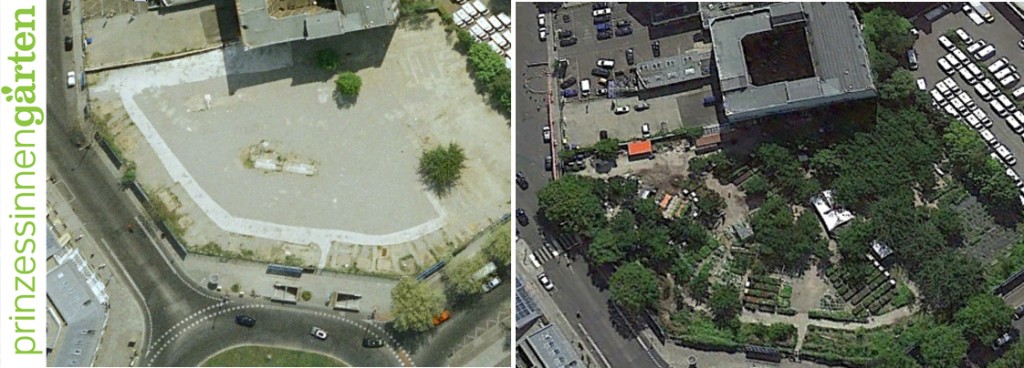
Pictures from Google Earth (Moritzplatz Berlin 2006/2012)
Nomadic Green and Princess Gardens
Nomadisch Grün (Nomadic Green) launched Prinzessinnengärten (Princess gardens) as a pilot project in the summer of 2009 at Moritzplatz in Berlin Kreuzberg, a site which had been a wasteland for over half a century. Along with friends, activists and neighbours, the group cleared away rubbish, built transportable organic vegetable plots and reaped the first fruits of their labour.
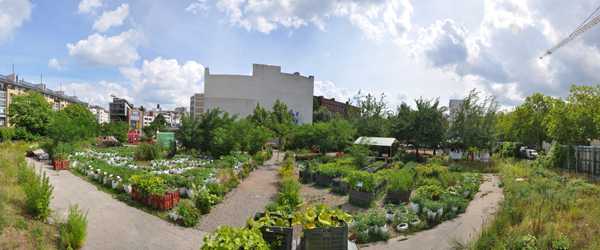
For a video about the Prinzessinnengarten with english subtitles click here
Imagine a future where every available space in big cities is used to let new green spaces bloom. Green spaces that local residents create themselves and use to produce fresh and healthy food. The result would be increased biological diversity, less CO2 and a better microclimate. The spaces would promote a sense of community and the exchange of a wide variety of competencies and forms of knowledge, and would help people lead more sustainable lives. They would be a kind of miniature utopia, a place where a new style of urban living can emerge, where people can work together, relax, communicate and enjoy locally produced vegetables.
In future ever more people will be living in cities rather than in rural areas. The city will therefore become the decisive place for the development of more sustainable ways of eating, living and moving. The city of the future should be a climate-friendly, pleasant place to live, where every care is taken to conserve our natural resources.
Prinzessinnengärten is a new urban place of learning. It is where locals can come together to experiment and discover more about organic food production, biodiversity and climate protection. The space will help them adapt to climate change and learn about healthy eating, sustainable living and a future-oriented urban lifestyle. With this project Nomadisch Grün intends to increase biological, social and cultural diversity in the neighbourhood and pioneer a new way of living together in the city
Picture Galery Princess Gardens 2009-2013
…………..
Some facts about Prinzessinnengarten
Nomadisch Grün (Nomadic Green) Starting in the summer of 2009, the non-profit company „Nomadisch Grün“ has leased a site in Berlin/Kreuzberg in order to create a mobile urban farm: The Prinzessinnengarten.
Locally grown organic vegetables Our fresh, organic, locally produced herbs and vegetables are grown in raised compost beds without using any pesticides or artificial fertilisers.
Mobile Gardening We temporarily transform unused spaces such as buildingsites, car parks and roofs into urban farmland and green meeting places.
Sustainable Living The Prinzessinnengarten is a place of discovery where children, neighbours, experts and those curious about sustainable living can come together to about and explore alternative visions for our city.
…………..
Prinzessinnengarten, Berlin © 2010 Monocle
…………..
Interview with Robert Shaw
by Ellen Mey, translated by Naomi Hanada
What was the concept for the garden?
I got the idea to start a garden when I was in Cuba. Many people, including city-dwellers,grow their own food in gardens there. Initially what was interesting to me were the visual contrasts between city/land or grey/green. As the plans for our garden started to come together, these contrasts became more interesting, for example, that between the socially conscious and the economic. When I saw that this idea works sustainably in Cuba, I became interested in the reasons and background, which was how the concept for this garden came about. In the beginning, it was just an idea with a very personal motivation behind it. I had recently become a father and could no longer imagine my career the way it was with a child in my life. I was working in theater and was constantly traveling. I wanted to spend time with my child and also do something that I can really stand behind. On my second trip to Cuba, I saw the same garden that I had visited two years prior, and I started to wonder if it would be possible to do something like that in Berlin. At first, I was naive in my approach, thinking that there are lots of empty lots and people would be happy if something were to happen there. The idea became more interesting as I explored the possibilities and gained an understanding of all the details. I asked myself, can I really do this? Can you bring a garden into the city? And if you are serious about running it as a business, can you earn a living with it?

Robert Shaw: Co-founder of Prinzessinnengarten
So between it being a personal project and a socially conscious mission, which aspect was in the foreground?
Let’s say it was the multitude of reasons that made it fun. This was as much an issue then as it is in this garden today. The tension between the socially conscious on one hand and being able to support oneself on the other was always there. The question is how to combine the two. Why gardening? I think the potential benefits of gardening as I have experienced it is that food is of universal appeal. In the beginning, I didn’t see it that way. Gardening was more like a personal hobby, where you somehow combine many positives, such as time, a different sense of managing it, as in, how long do plants need to grow, and the work itself, which with its fleeting nature also leaves room for social interactions. Perhaps it is also the romantic image of gardening that reminds me of my childhood.
Can you describe this image? How did you imagine gardening?
Back then my idea of bliss was leisurely taking care of brand new radish saplings with lots of friends and a couple of newcomers, watering and nurturing them, and chatting with folks who are similarly interested in these things. A very sunny and romantic image, which didn’t have a lot to do with the overwhelming amount of communication and organization that is actually required.
What happened to this romantic image when it came time to earn a living with your gardening idea?
To even understand the financial aspect was a process. Indeed, this garden started with this romantic image of cooperative gardening and learning, and also of personal growth and a dialogue about food. And indeed there was the question of how you would ever make money doing this. Sure, I assumed that empty lots are easily available. But you can’t even meet the basic cost of living with growing vegetables. Selling the vegetables would be hopeless. There is a reason why nearly all farmers are subsidized these days. However, processing the vegetables, cooking them, and offering that as a selling point at the garden cafe, and to then make money with this eatery like you would with any other —this was the original idea of financing the garden. I did a lot of research to see what models already existed and what could work. Since
What happened to this image in your head? What does the reality look like today?
What I imagined as far as the leisurely cooperative learning and gardening certainly exists in the garden, but I’m not necessarily the one doing it. We keep a space available so that people have the opportunity to get involved in the garden as they wish. What I do in the garden is a sort of management and endless multitasking. One aspect of the garden is to address a variety of matters and thereby attract lots of different people with their own interests, people who then get to express their interests by asking questions. What I do above all in the garden is to coordinate these two fundamental interests, that is, for people to help in the garden and to ask questions. It typically doesn’t include my touching plants very much. So for me, the romantic image is realized only in the watering of the garden,not the gardening itself.
This interview is an excerpt from our book on Prinzessinnengarten
…………..

Grafik: Natalia Hosie
Cultivating a Different City / Marco Clausen
This Text is an excerpt from the introduction of our Book on Prinzesinnengarten (2012), translated by Alexander Paulick-Thiel
Rural life in the big city – a kind of idyll
If you happen to be stopping at Moritzplatz in Berlin Kreuzberg on an early summer’s day, you just might witness a moving spectacle. Ten thousand or more bees swarm over the square. It’s a surprising sight, as the square is otherwise what could be described as a non-place. It is a transit area, dominated by a busy roundabout. Here, within view of where the Berlin Wall once stood, history has thrown together a heterogeneous urban ensemble of parking lots, disused land, a few remaining Wilhelminian buildings, residential blocks hastily constructed during the postwar period, four oversized subway exits, a mobile snack bar, and the concrete and glass structure of a recently opened department store for creative supplies. The site seems rough and uninviting. What, one wonders, has lured these bees here? The answer is hidden behind a wire fence that is overgrown with hops and lined with billboards. On this bombed-out site, between the roundabout, the subway station, and a 22-foot high firewall, grows a garden. Entering through a door in the fence, the noise of the city becomes slightly muffled. The pace slows down. People can be found gardening in the planter beds, walking among the plants or sitting in the sun drinking coffee. All kinds of herbs and vegetables can be found sprouting from the plastic baskets: turnips, carrots, parsnips, kale, red Russian kale, radishes, fennel, basil, tarragon, sage, thyme, lovage, salad burnet, sorrel, chard, orache, charlock mustard and purslane. Between them are the luminescent blossoms of dandelion, cornflower, nasturtium, borage and malva. Growing in rice sacks are different varieties of potatoes with revolutionary or royal names like Red Emma and King Edward. Tomato plants have grown tall on improvised trellises, promising yellow, red and black, plum and heart-shaped fruits for the autumn. Seedlings are sold in modified Tetra Paks from a shipping container that has been converted into a sales stall. A signboard indicates which vegetables are ripe enough for visitors to harvest themselves. Another signboard announces days when visitors can work in the garden. Anyone can participate, or attend workshops on seed harvesting or pickling vegetables. Amongst a grove of robinias, also in converted containers, are a garden bar and a kitchen. Groups of guests sit at homemade tables built out of drink crates and eat meals prepared with produce that has been freshly harvested from the garden.
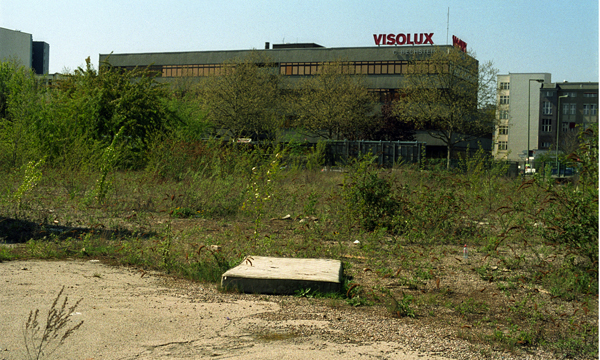
Brownfield at Moritzplatz, summer 2009
The Prinzessinnengarten
The Prinzessinnengarten is an urban vegetable garden. Here in the city center, on a plot that lay disused for decades, vegetables are grown. The garden owes its existence to the commitment of countless neighbors, friends and interested people. In just a few summers, their work, their passion, their diverse skills and ideas have transformed this forgotten place into a new form of urban greenery. The people and motivations that make this place possible are as varied as the garden itself.
The Prinzessinnengarten is located in the Kreuzberg 36 district of Berlin, between Prinzenstraße, Oranienstraße and Prinzessinnenstraße, and is about the size of a soccer field. Here, exclusively agricultural crops are cultivated, locally and organically. The garden as a whole is mobile. The bar, kitchen, workshop and storage facilities are located in disused and converted shipping containers. Crops are planted in raised beds made from stacked crates or in rice sacks. A method of cultivation that is independent from the ground below, combined with the use of food-grade materials, allows for organic farming in a city where the lands available are usually either paved or contaminated. In addition, a mobile garden allows for the possibility of temporary use. The Prinzessinnengarten rents the land at Moritzplatz from the city. The possible privatization of this land could lead to the relocation of the garden to a different site. Income is generated through the garden’s restaurant and the sale of vegetables, from funds that we acquire for the implementation of various educational projects, from the construction of other gardens, consulting services, fees for images, presentations and guided tours, as well as donations in form of planter and garden sponsorships. Nobody owns their own bed at the Prinzessinnengarten. Many people are involved voluntarily in order to make a place like this possible. As a framework for the different social, educational and economic activities here, we have established a non-profit company called Nomadisch Grün (Nomadic Green), with the primary aim of making the garden a place of learning. Since we are mostly amateurs and beginners, the emphasis is mainly on informal learning. Skills are gained through practical experience and the sharing of knowledge.
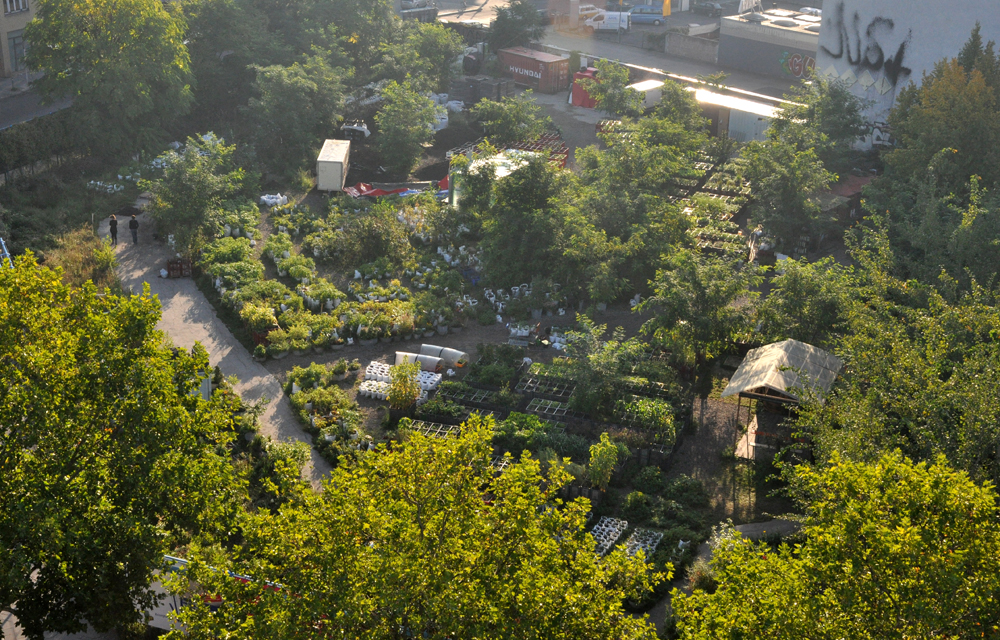
Prinzessengarten 2010
The Prinzessinnengarten is more than just a place to grow vegetables in the city. It is a space for diverse activities. Through the opportunity to contribute and to participate in open workshops, through the garden café and a variety of cultural events, the Prinzessinnengarten has become a lively meeting place with appeal far beyond the neighborhood. At the same time, it is an example of a new type of gardening in the city. Lately, more and more is being heard about gardens that have little to do with the typical ideas of green in the city or with parks, front gardens or allotments. Through such gardens and their participants, terms such as urban gardening, urban agriculture, community gardens, city farms or guerrilla gardening have found their way into common usage. This phenomenon can be observed in the most varied of forms in many cities around the world. Community gardens and urban farming projects are especially widespread in North America. The appearance and size of these gardens as well as the motivations and ideas of the gardeners may vary greatly in detail. What these gardens have in common, alongside the focus on local food production, is that they are developed as community projects and on their own initiative. In addition, gardening is not only understood as a pleasant pastime, with the garden as a private retreat. The alternative use of urban land, self-sufficiency and community work are also generally associated with wider societal issues. Through practical activity, this new garden movement takes up issues like biodiversity, healthy eating, recycling, environmental justice, climate change and food sovereignty. Urban gardens practically demonstrate an ecologically and socially different approach to urban spaces and their inhabitants, enable the social empowerment of marginalized communities, and are places where opportunities for local micro-economies and other economic models are being tested. In an unobtrusive and pragmatic way, such gardens raise the question of how we want to live in our cities in the future.
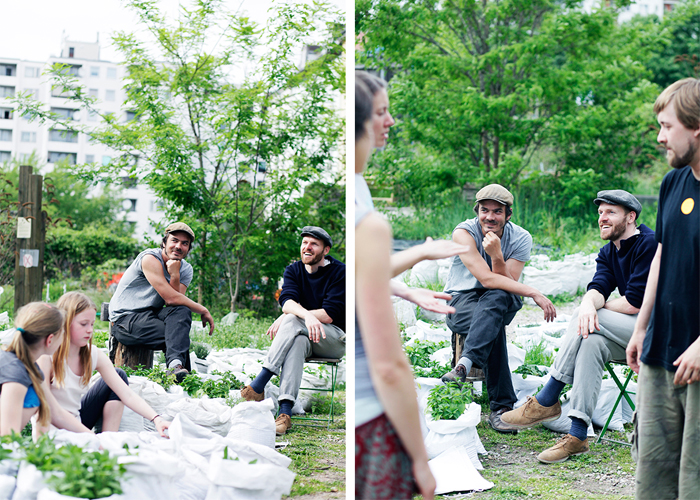
Robert Shaw & Marco Clausen / Co-Founder (Picture: Ute Langkafel / MAIFOTO)
…………..
Interview: “Urban Gardens: sowing the Cities of Tomorrow”
Kito Nedo talking to Marco Clausen, published in: SLUM Lab – Sustainable Living Urban Model / Issue 8. The Social Design Public Action Reader (Fall 2013) (download pdf)
…………..
Prinzessinnengarten – Berlin, Germany from Joseph Redwood-Martinez
…………..
International Press
ENGLISH
Prinzessengarten, in: Social Innovations for Social Cohesion. Transnational patterns and approaches from 20 European Cities, Adalbert Evers, Benjamin Ewert and Taco Brandsen (eds.), WILCO 2014
The so-called Princesses Gardens in Kreuzberg offer a complex project that attempts to change people’s mind sets on a broader scale than most of the pragmatic solutions in the realm of welfare. As a part of the international urban gardening movement, the highly attractive project pursues an alternative approach how to use urban space ecologically and sustainably … By creating a huge urban garden area on former wasteland in the centre of the district, the project demonstrates that cooperation and common learning among a heterogeneous urban citizenry is possible.
e-Reader / excerpt PrincessesGarden as a PDF
Food and the City, Huffington Post (22.08.2013)
“Princess Gardens” — and the name says it all: the urban agriculture and community farming lot is a beautiful and bohemian little wilderness with a touch of fairy tale.
30,000 people signed the petition to save Berlin’s Prinzessinnengärten garden, City Farmer News (Januar 2013)
First we fix the garden, then we take Berlin, Stockholm Resilience Center (04.12.2012) / SustainableCitiesCollective
Prinzessinnengärten: A Garden Grows Community: planet FORWARD (24.10.2012)
Urban paradise under threat, auf: Deutsche Welle – Global Ideas (12.10.2012)
Lotus in the fields, Lotus 149 (2012)
The cultivation of an open urban space seems an exciting proposition and probably an aesthetic cultural medium in which to try out new forms of living together and developing fertile community relations, and this might have consequences.
Urban Farming. Approaches of sustainable agriculture in several of the world`s largest cities, in: Cool Hunting (20.04.2012)
Urban agriculture blossoms in Berlin, Deutsche Welle World (02.09.2011)
A rainy Interview, on: Gidsy (08/2011)
Interview with Marco Clausen from the Prinzessinnengarten by Gidsy
A Visit to the Prinzessinnengarten. Berlin’s Mobile Community Garden, in: Soiled and Seeded #4 2011
Urban Farming Takes Root in Europe, in: Inter Press Service News Agency (2011)
A Visit to the Prinzessinnengarten. Berlin’s Mobile Community Garden, in: Soiled and Seeded #4 2011
Berlin’s Mobile Garden Grows, in New York Times (28.02.2011)
Monocle News Report about the Prinzessinnengarten
The Mobile Garden. About Berlin sprouts, Kreuzberger kraut and Princess beans, in: DAMn magazine #27 (2011)
Gardening goes guerilla in Berlin, in: The Local (15.05.2011)
Sites of Berlin’s industrial past get a second life, CNN (16.11.2010)
‘The Greenmaker, in viewpoint # 27 (2010)
Off-grid living has spread over the past 10 years from grassroots communities to major towns and conurbations. The new breed of Greenmakers lives in cities ans utilises the DIY movements and DIY skills to spread the message about a more sustainable, self-sufficient, more off-grid life … Prinzessinnengarten: a place for sustainable living and a future-oriented urban lifestyle.”
ITALIAN
L’orto urbano di Berlino, in: il manifesto (30.08.2011)
La agricultura europea echa raíces en la ciudad (La Republica)
Guerrigli gardening: Berlino è caduta a colpi di semi (Cafebabel)
Prinzessinnengarten/L’orto in città, in: WU Magazine #21 (Juni 2011, Italien)
Il prodotto bio è fai da te, in: business 9/2010
SPANISH
Huertas urbanas: Tres proyectos que integran producción de alimentos en la ciudad, in Tree Hugger Latinoamérica (27.04.2012)
¡Verde Nómade!, in: plot vom 10.02.2012 (Argentina)
La agricultura urbana se pone de moda en Europa (eco book)
‘Guerrilla gardening’: Conquista un trozo de suelo y conviértelo en jardín (cafebabel)
FRENCH
Des cultures et des villes von AgroParisTech
Berlin cultive son jardin, in: M le magazine du Monde (05.10.2012)
La agricultura urbana se pone de moda en Europa (eco book, 2011)
Agriculture Periurbanisme. Oxymore ou nouvelle harmonie, in: Egologik (Frankreich) #21 (06/07 2011)
L’agriculture s’installe en ville, in: Courrier INTERNATIONAL (11.08.2010)
Guérilla jardinière à Berlin : un autre monde est plantable! (cafebabel)
PIRATES BOTANIQUES DANS LES SOUS-BOIS URBAINS : COMMENT PARIS ET BERLIN REFLEURISSENT
Transporter son jardin, in: Courier international okt. – dez. 2010 (vivre léger. 60 tendances pour demain)
CHINA
城市农耕,荒芜处绿洲 Urban Farming, in: LOHAS 乐活·健康时尚 (China) Februar 2012
NORWAY
Rotløs hage midt i storbyen, in: Aftenposten vom 04.09.2010
RUSSIA
BRASIL / PORTOGUESE
Agricultura urbana na Europa, in: envolverde (18.07.2011)
Hortas comunitárias se popularizam em Berlim, laparola (17.02.2014)
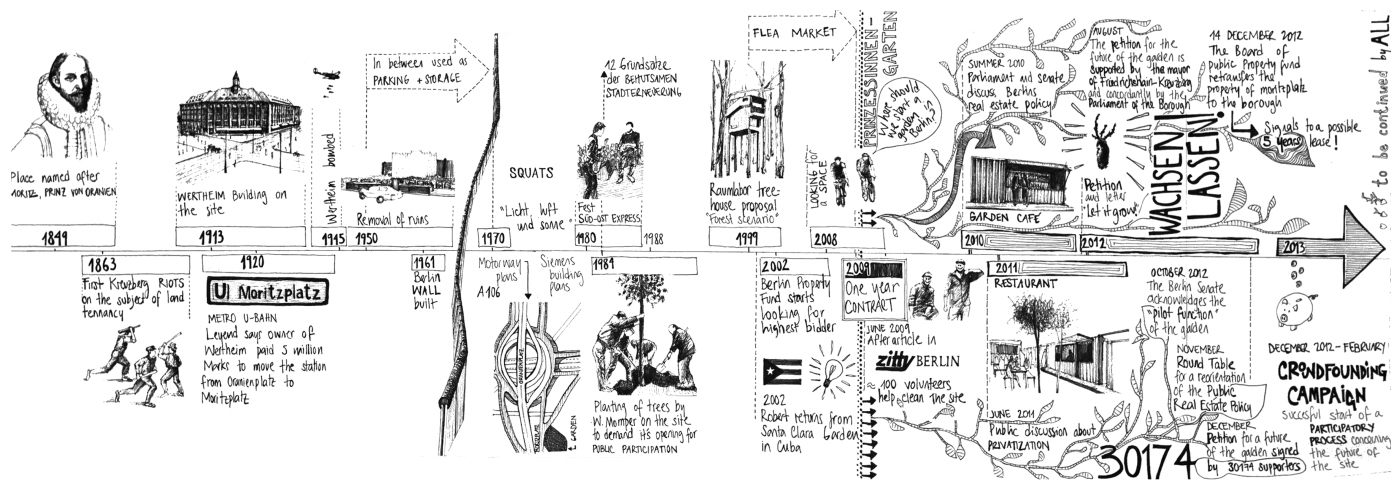
„History of Space“ von hosiewulff

